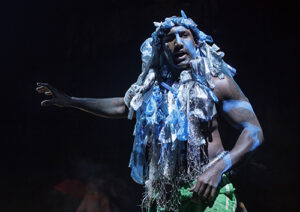Once on This Island
Circle in the Square Theatre, NYC, December 4, 2017
Reviewed by Elizabeth Ahlfors for Cabaret Scenes
Photos: Joan Marcus

Once on This Island is 90 minutes of Caribbean fantasy, a romance of passion and a tale of renewal celebrated in spirited music and song. The Circle in the Square Theatre is transformed into a beach in the French Antilles, galvanized with vibrant fabrics on the walls, props, and performers buzzing through the aisles and on the sandy stage. Peasants busily clean up the damage wrought by an earlier violent storm, singing and dancing as they pick up branches, carry cages of chickens, and lead a goat in a diaper around the stage and into the audience.

This was the third musical written by lyricist/librettist Lynn Ahrens and composer Stephen Flaherty (Ragtime, Anastasia), their first to play Broadway (1990). Based on the novel My Love, My Love by Rosa Guy, the story is divided by class and racial divisions, the wealthy “grandes hommes” and the struggling peasants. That divisiveness is played out in the ill-fated fable of a dark-skinned African-American peasant girl, Ti Moune (Hailey Kilgore), and a young wealthy biracial land owner, Daniel Beauxhomme, a fairy tale romance that borders on chaos in the show’s wall-to-wall activity.
Under Michael Arden’s intense direction, the secret of falling under the spell of this sung-through musical is to forget reality and succumb to illusion. On Dane Laffrey’s detailed island fantasy, with evocative lighting by Jules Fisher and Peggy Eisenhauer, the energetic cast dives into the island culture with its ruling gods and goddesses. The peasants live their lives, singing, “To the music of the gods, we dance!” The richer class lives in luxury and makes its own rules.

With choreographer Camille A. Brown’s rhythmic dances, an effervescent calypso sequence (“Ti Moune’s Dance”) is highlighted with limber eloquence and new orchestrations by Annmarie Milazzo and Michael Starobin. Director Arden presents various deities, including Lea Solonga as Erzulie, the gentle Goddess of Love, and Quentino Earl Darrington as Agwe, ruler of the waters. Earth Mother Asaka is played by Alex Newell and, most theatrical, is Merle Dandridge’s deadly demon, Papa Ge.
The play begins with a hurricane and “One Small Girl” (Emerson Davis), who survives the storm and sits traumatized in a tree. The company tries to comfort her by telling her the fairy tale of Ti Moune, and Phillip Boykin and Kenita R. Miller, playing an loving older couple, decide to raise the child themselves, naming her Ti. She is a headstrong, vivacious child, and in a delightful magical move, she grows into a lithe beauty played by Hailey Kilgore, making her Broadway debut. Kilgore inhabits the elegance and perception needed for her portrayal of Ti. A graceful dancer and forceful vocalist, she has one super-solo: “Waiting for Life.”
Ti Moune becomes infatuated with a wealthy young man, Daniel Beauxhomme, and when he has an accident, she is determined to save his life. Their headstrong daughter prays to the gods to save Daniel’s life and help nurture their love, but the gods argue among themselves. Protective of Ti, Erzaulie claims that love conquers all. Fierce Papa Ge threatens a challenging end. Newell, as the nurturing Asaka, promises “Mama Will Provide.”

Love does not conquer all and, between the gods and the class divisions, Ti Moune’s heart is broken and she dies. Love, however, does have power and transcendency. This slight, meandering story transforms the young woman into a tree, becoming “A Part of Us,” sheltering and nourishing. (Unfortunately, this tree is not luxurious and blooming, but just a log.) Once again, it’s best to forget about reality and bossy deities and succumb to the illusion of island myths and rhythms.
Unfortunately, much of the lusty singing is over-amplified and, while Flaherty’s melodies are catchy and often lovely, Ahrens’ lyrics are not distinct, muddling her usual sense and clarity.
It is Clint Ramos’ theatrical costume design that best distinguish the various gods. Goddess Erzulie is all purity in flowing white, and Papa Ge resembles a menacing dragon. Ramos also designed elegant gowns for the landowner, contrasting against the tatters of the peasants.





